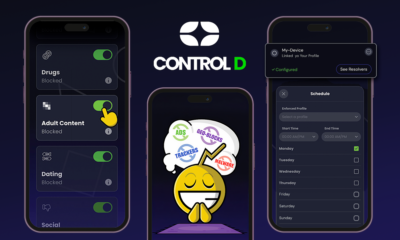TECHNOLOGY
Full ‘stream’ ahead for Scottish Water smart monitoring roll-out

An intelligent monitoring system has been successfully introduced by Scottish Water across rural locations in the Highlands and Islands, using Internet of Things (IoT) technology to gather essential data that helps keep the water network in Scotland safe.
Using a device developed by CENSIS for M2M Cloud – Scotland’s innovation centre for sensing, imaging, and IoT technologies – Scottish Water can now automatically collect information on the temperature and flow of water in Scottish Water buildings as part of routine quality assurance checks. Any unusual readings could point towards a potentially harmful bacteria outbreak, including legionella. Until now, the process was carried out manually with employees travelling the country to undertake regular testing.
Working as a supplier to Scottish Water’s Digital Framework partners, Atos, M2M Cloud’s Gemini devices have so far been deployed across all Scottish Water sites in Shetland, Orkney and Islay. The next phase of the roll-out will extend the deployment to a further 300 sites, covering around half of the network. The installation of the smart water monitoring systems forms part of a wider commitment to digital transformation at Scottish Water, led by Atos.
The first of its kind device fits on to the surface of pipes to remotely take temperature readings, notifying building managers if the water system is out of specification. Readings are taken every 10 seconds, looking at minimum and maximum temperatures, as well as detecting any issues with water flow events.
This latest generation of the rechargeable battery-powered device was developed CENSIS for M2M, after receiving grant funding from Scottish Enterprise last year. The device is now capable of operating on both cellular Narrow Band IoT (NB-IoT) and LoRaWAN networks, making the system easier to set up in hard-to-reach areas. The addition of Bluetooth connectivity has cut installation times by one-third.
Chris Butchart, director at M2M Cloud, said: “Water monitoring has typically been a carbon-intensive, resource-heavy process involving engineers taking manual readings monthly. For Scottish Water, the ability to gather that data on a continuous basis will be transformational in terms of the way it operates remote sites and ensures safe conditions are met. To have Scottish Water as the first organisation to use our latest generation device is a huge vote of confidence and we look forward to the next stage of the roll-out.”
M2M Cloud’s system can reduce carbon emissions associated with water monitoring by up to 75% – around 300kgs of CO2 per year for each monitored asset – by removing the need for travel to the site and the necessity to overheat water supplies, which organisations often do to avoid the risk of bacteria outbreaks. Water wastage is also reduced by around 225,000 litres per asset, per year.
The device’s battery can last for up to five years before needing recharged, rather than replaced, and can be charged while the device remains in situ attached to the pipework. It is also the only water safety device to have been awarded IASME Gold level certification – an industry-recognised measure of IoT cyber security.
Monitoring water systems in UK non-domestic buildings is a statutory requirement costing around £140 million per annum, while financial estimates put the healthcare and workplace impact of legionella alone at £1 billion per year across Europe. It is anticipated that the Health and Safety Executive compliance legislation will soon evolve to include remote technology-led monitoring as part of legionella prevention.
Kevin Power, system architect at CENSIS, said: “It is great to see the successful use of a 5G ready IoT device wholly designed and manufactured in Scotland, by one of our biggest utility providers. We have supported M2M Cloud since the early stages of development and the business continues to go from strength to strength. The latest generation of the technology represents a big step forward in terms of ease of connectivity and will support the growing demand from businesses for digital transformation and IoT.”
Archie MacGregor, property manager, at Scottish Water added: “The remote temperature monitoring sensors have been a major step forward in enhancing the management of H&S in our building water systems as well as offering significant benefits in reducing journeys to site and related carbon emissions. We are delighted to have M2M and CENSIS working with us in delivering these innovative solutions which completely align with our Strategic Ambitions of Net Zero Emissions and providing Great Value for our customers.”
Innovation Minister Richard Lochhead said: “This is an excellent example of how Internet of Things technology can provide smart solutions to monitor essential data that helps keep the water network in Scotland safe.
“Collecting this information remotely can transform this previously carbon-intensive process and demonstrates the potential for innovations to support our net zero ambitions. The deployment across all Scottish Water sites in Shetland, Orkney and Islay, with plans to extend the roll-out to a further 300 locations, shows the opportunity to scale up this technology.
“Ensuring Scotland can realise the full economic benefits of the digital and data economy is fundamental to the Scottish Government’s National Strategy for Economic Transformation. As a key enabler of sustainable economic growth, digital infrastructure is a critical part of our plans for a fair, green and growing economy.”
Want to learn more about cybersecurity and the cloud from industry leaders? Check out Cyber Security & Cloud Expo taking place in Amsterdam, California, and London. Explore other upcoming enterprise technology events and webinars powered by TechForge here.
TECHNOLOGY
Next-gen chips, Amazon Q, and speedy S3

AWS re:Invent, which has been taking place from November 27 and runs to December 1, has had its usual plethora of announcements: a total of 21 at time of print.
Perhaps not surprisingly, given the huge potential impact of generative AI – ChatGPT officially turns one year old today – a lot of focus has been on the AI side for AWS’ announcements, including a major partnership inked with NVIDIA across infrastructure, software, and services.
Yet there has been plenty more announced at the Las Vegas jamboree besides. Here, CloudTech rounds up the best of the rest:
Next-generation chips
This was the other major AI-focused announcement at re:Invent: the launch of two new chips, AWS Graviton4 and AWS Trainium2, for training and running AI and machine learning (ML) models, among other customer workloads. Graviton4 shapes up against its predecessor with 30% better compute performance, 50% more cores and 75% more memory bandwidth, while Trainium2 delivers up to four times faster training than before and will be able to be deployed in EC2 UltraClusters of up to 100,000 chips.
The EC2 UltraClusters are designed to ‘deliver the highest performance, most energy efficient AI model training infrastructure in the cloud’, as AWS puts it. With it, customers will be able to train large language models in ‘a fraction of the time’, as well as double energy efficiency.
As ever, AWS offers customers who are already utilising these tools. Databricks, Epic and SAP are among the companies cited as using the new AWS-designed chips.
Zero-ETL integrations
AWS announced new Amazon Aurora PostgreSQL, Amazon DynamoDB, and Amazon Relational Database Services (Amazon RDS) for MySQL integrations with Amazon Redshift, AWS’ cloud data warehouse. The zero-ETL integrations – eliminating the need to build ETL (extract, transform, load) data pipelines – make it easier to connect and analyse transactional data across various relational and non-relational databases in Amazon Redshift.
A simple example of how zero-ETL functions can be seen is in a hypothetical company which stores transactional data – time of transaction, items bought, where the transaction occurred – in a relational database, but use another analytics tool to analyse data in a non-relational database. To connect it all up, companies would previously have to construct ETL data pipelines which are a time and money sink.
The latest integrations “build on AWS’s zero-ETL foundation… so customers can quickly and easily connect all of their data, no matter where it lives,” the company said.
Amazon S3 Express One Zone
AWS announced the general availability of Amazon S3 Express One Zone, a new storage class purpose-built for customers’ most frequently-accessed data. Data access speed is up to 10 times faster and request costs up to 50% lower than standard S3. Companies can also opt to collocate their Amazon S3 Express One Zone data in the same availability zone as their compute resources.
Companies and partners who are using Amazon S3 Express One Zone include ChaosSearch, Cloudera, and Pinterest.
Amazon Q
A new product, and an interesting pivot, again with generative AI at its core. Amazon Q was announced as a ‘new type of generative AI-powered assistant’ which can be tailored to a customer’s business. “Customers can get fast, relevant answers to pressing questions, generate content, and take actions – all informed by a customer’s information repositories, code, and enterprise systems,” AWS added. The service also can assist companies building on AWS, as well as companies using AWS applications for business intelligence, contact centres, and supply chain management.
Customers cited as early adopters include Accenture, BMW and Wunderkind.
Want to learn more about cybersecurity and the cloud from industry leaders? Check out Cyber Security & Cloud Expo taking place in Amsterdam, California, and London. Explore other upcoming enterprise technology events and webinars powered by TechForge here.
TECHNOLOGY
HCLTech and Cisco create collaborative hybrid workplaces

Digital comms specialist Cisco and global tech firm HCLTech have teamed up to launch Meeting-Rooms-as-a-Service (MRaaS).
Available on a subscription model, this solution modernises legacy meeting rooms and enables users to join meetings from any meeting solution provider using Webex devices.
The MRaaS solution helps enterprises simplify the design, implementation and maintenance of integrated meeting rooms, enabling seamless collaboration for their globally distributed hybrid workforces.
Rakshit Ghura, senior VP and Global head of digital workplace services, HCLTech, said: “MRaaS combines our consulting and managed services expertise with Cisco’s proficiency in Webex devices to change the way employees conceptualise, organise and interact in a collaborative environment for a modern hybrid work model.
“The common vision of our partnership is to elevate the collaboration experience at work and drive productivity through modern meeting rooms.”
Alexandra Zagury, VP of partner managed and as-a-Service Sales at Cisco, said: “Our partnership with HCLTech helps our clients transform their offices through cost-effective managed services that support the ongoing evolution of workspaces.
“As we reimagine the modern office, we are making it easier to support collaboration and productivity among workers, whether they are in the office or elsewhere.”
Cisco’s Webex collaboration devices harness the power of artificial intelligence to offer intuitive, seamless collaboration experiences, enabling meeting rooms with smart features such as meeting zones, intelligent people framing, optimised attendee audio and background noise removal, among others.
Want to learn more about cybersecurity and the cloud from industry leaders? Check out Cyber Security & Cloud Expo taking place in Amsterdam, California, and London. Explore other upcoming enterprise technology events and webinars powered by TechForge here.
TECHNOLOGY
Canonical releases low-touch private cloud MicroCloud

Canonical has announced the general availability of MicroCloud, a low-touch, open source cloud solution. MicroCloud is part of Canonical’s growing cloud infrastructure portfolio.
It is purpose-built for scalable clusters and edge deployments for all types of enterprises. It is designed with simplicity, security and automation in mind, minimising the time and effort to both deploy and maintain it. Conveniently, enterprise support for MicroCloud is offered as part of Canonical’s Ubuntu Pro subscription, with several support tiers available, and priced per node.
MicroClouds are optimised for repeatable and reliable remote deployments. A single command initiates the orchestration and clustering of various components with minimal involvement by the user, resulting in a fully functional cloud within minutes. This simplified deployment process significantly reduces the barrier to entry, putting a production-grade cloud at everyone’s fingertips.
Juan Manuel Ventura, head of architectures & technologies at Spindox, said: “Cloud computing is not only about technology, it’s the beating heart of any modern industrial transformation, driving agility and innovation. Our mission is to provide our customers with the most effective ways to innovate and bring value; having a complexity-free cloud infrastructure is one important piece of that puzzle. With MicroCloud, the focus shifts away from struggling with cloud operations to solving real business challenges” says
In addition to seamless deployment, MicroCloud prioritises security and ease of maintenance. All MicroCloud components are built with strict confinement for increased security, with over-the-air transactional updates that preserve data and roll back on errors automatically. Upgrades to newer versions are handled automatically and without downtime, with the mechanisms to hold or schedule them as needed.
With this approach, MicroCloud caters to both on-premise clouds but also edge deployments at remote locations, allowing organisations to use the same infrastructure primitives and services wherever they are needed. It is suitable for business-in-branch office locations or industrial use inside a factory, as well as distributed locations where the focus is on replicability and unattended operations.
Cedric Gegout, VP of product at Canonical, said: “As data becomes more distributed, the infrastructure has to follow. Cloud computing is now distributed, spanning across data centres, far and near edge computing appliances. MicroCloud is our answer to that.
“By packaging known infrastructure primitives in a portable and unattended way, we are delivering a simpler, more prescriptive cloud experience that makes zero-ops a reality for many Industries.“
MicroCloud’s lightweight architecture makes it usable on both commodity and high-end hardware, with several ways to further reduce its footprint depending on your workload needs. In addition to the standard Ubuntu Server or Desktop, MicroClouds can be run on Ubuntu Core – a lightweight OS optimised for the edge. With Ubuntu Core, MicroClouds are a perfect solution for far-edge locations with limited computing capabilities. Users can choose to run their workloads using Kubernetes or via system containers. System containers based on LXD behave similarly to traditional VMs but consume fewer resources while providing bare-metal performance.
Coupled with Canonical’s Ubuntu Pro + Support subscription, MicroCloud users can benefit from an enterprise-grade open source cloud solution that is fully supported and with better economics. An Ubuntu Pro subscription offers security maintenance for the broadest collection of open-source software available from a single vendor today. It covers over 30k packages with a consistent security maintenance commitment, and additional features such as kernel livepatch, systems management at scale, certified compliance and hardening profiles enabling easy adoption for enterprises. With per-node pricing and no hidden fees, customers can rest assured that their environment is secure and supported without the expensive price tag typically associated with cloud solutions.
Want to learn more about cybersecurity and the cloud from industry leaders? Check out Cyber Security & Cloud Expo taking place in Amsterdam, California, and London. Explore other upcoming enterprise technology events and webinars powered by TechForge here.
-

 MARKETING7 days ago
MARKETING7 days agoBattling for Attention in the 2024 Election Year Media Frenzy
-

 WORDPRESS7 days ago
WORDPRESS7 days ago7 Best WooCommerce Points and Rewards Plugins (Free & Paid)
-

 WORDPRESS6 days ago
WORDPRESS6 days ago13 Best HubSpot Alternatives for 2024 (Free + Paid)
-

 MARKETING6 days ago
MARKETING6 days agoAdvertising in local markets: A playbook for success
-

 SEARCHENGINES6 days ago
SEARCHENGINES6 days agoGoogle Core Update Flux, AdSense Ad Intent, California Link Tax & More
-

 AFFILIATE MARKETING7 days ago
AFFILIATE MARKETING7 days agoGrab Microsoft Project Professional 2021 for $20 During This Flash Sale
-

 PPC4 days ago
PPC4 days ago10 Most Effective Franchise Marketing Strategies
-

 MARKETING5 days ago
MARKETING5 days agoHow to Use AI For a More Effective Social Media Strategy, According to Ross Simmonds













